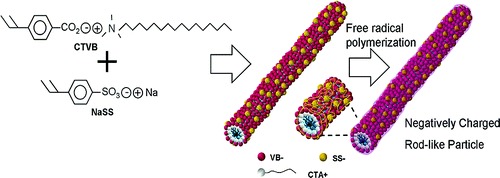Publication
 HOME > Publications > Publication
HOME > Publications > Publication Polymerized Rodlike Nanoparticles with Controlled Surface Charge Density Hit : 350
Tae-Hwan Kim, Sung-Min Choi and Steven R. Kline
Vol. 22, No. 6, P. 2844 - 2850, (2006)
 http://dx.doi.org/10.1021/la052949a
http://dx.doi.org/10.1021/la052949a
Abstract

Stable rodlike nanoparticles with highly controlled surface charge density have been developed by the free radical polymerization of the mixture of polymerizable cationic surfactant, cetyltrimethylammonium 4-vinylbenzoate (CTVB), and hydrotropic salt sodium 4-styrenesulfonate (NaSS) in aqueous solution. The surface charge of the polymerized CTVB/NaSS rodlike nanoparticles was controlled by varying the NaSS concentration during the polymerization process, and the charge variation was interpreted in terms of the overcharging effect in colloidal systems. The SANS measurements show that the diameter of the polymerized CTVB/NaSS rodlike nanoparticles is constant at 4 nm and the particle length ranges from 24 to 85 nm, depending on the NaSS concentration. The polymerized particles are longest when the NaSS concentration is 5 mol % which corresponds to the charge inversion or neutral point. The SANS and zeta potential measurements show that the Coulomb interactions between the particles are strongly dependent on the NaSS concentration and the zeta potential of the polymerized CTVB/NaSS nanoparticles changes from positive to negative (+12.8 ∼ −44.2 mV) as the concentration of NaSS increases from 0 to 40 mol %. As the NaSS concentration is further increased, the zeta potential is saturated at approximately −50 mV.
김태환 Langmuir 2006.jpg
Vol. 22, No. 6, P. 2844 - 2850, (2006)
 http://dx.doi.org/10.1021/la052949a
http://dx.doi.org/10.1021/la052949a
Abstract

Stable rodlike nanoparticles with highly controlled surface charge density have been developed by the free radical polymerization of the mixture of polymerizable cationic surfactant, cetyltrimethylammonium 4-vinylbenzoate (CTVB), and hydrotropic salt sodium 4-styrenesulfonate (NaSS) in aqueous solution. The surface charge of the polymerized CTVB/NaSS rodlike nanoparticles was controlled by varying the NaSS concentration during the polymerization process, and the charge variation was interpreted in terms of the overcharging effect in colloidal systems. The SANS measurements show that the diameter of the polymerized CTVB/NaSS rodlike nanoparticles is constant at 4 nm and the particle length ranges from 24 to 85 nm, depending on the NaSS concentration. The polymerized particles are longest when the NaSS concentration is 5 mol % which corresponds to the charge inversion or neutral point. The SANS and zeta potential measurements show that the Coulomb interactions between the particles are strongly dependent on the NaSS concentration and the zeta potential of the polymerized CTVB/NaSS nanoparticles changes from positive to negative (+12.8 ∼ −44.2 mV) as the concentration of NaSS increases from 0 to 40 mol %. As the NaSS concentration is further increased, the zeta potential is saturated at approximately −50 mV.



